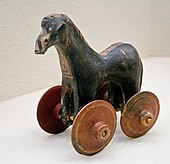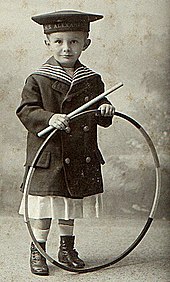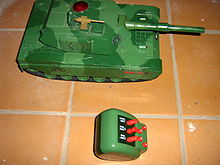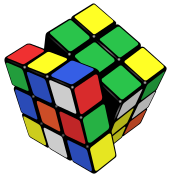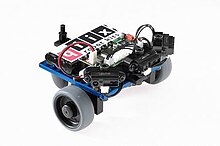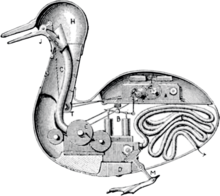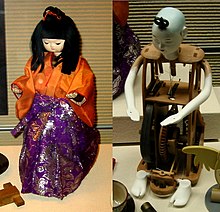A variety of traditional wooden Channapatna toys from India
A toy is an item that is used in play,
especially one designed for such use. Playing with toys can be an
enjoyable means of training young children for life in society.
Different materials like wood, clay, paper, and plastic are used to make
toys. Many items are designed to serve as toys, but goods produced for
other purposes can also be used. For instance, a small child may fold an
ordinary piece of paper into an airplane shape and "fly it". Newer
forms of toys include interactive digital entertainment. Some toys are produced primarily as collectors' items and are intended for display only.
The origin of toys is prehistoric; dolls representing infants,
animals, and soldiers, as well as representations of tools used by
adults are readily found at archaeological sites. The origin of the word
"toy" is unknown, but it is believed that it was first used in the 14th
century. Toys are mainly made for children. The oldest known doll toy is thought to be 4,000 years old.
Playing with toys is considered to be important when it comes to
growing up and learning about the world around us. Younger children use
toys to discover their identity, help their bodies grow strong, learn
cause and effect, explore relationships, and practice skills they will
need as adults. Adults on occasion use toys to form and strengthen
social bonds, teach, help in therapy, and to remember and reinforce
lessons from their youth.
History
Antiquity
Little horse on wheels, Ancient Greek children's toy. From a tomb dating 950–900 BCE, Kerameikos Archaeological Museum, Athens
Most children have been said
to play with whatever they can find, such as sticks and rocks.
Toys and games have been unearthed from the sites of ancient
civilizations. They have been written about in some of the oldest
literature. Toys excavated from the Indus valley civilization (3010–1500 BCE) include small carts, whistles shaped like birds, and toy monkeys which could slide down a string.
The earliest toys are made from materials found in nature, such as rocks, sticks, and clay. Thousands of years ago, Egyptian children played with dolls that had wigs and movable limbs which were made from stone, pottery, and wood.
Given their love of games, it is highly likely that the ancient
Egyptians also had children's toys, but they are exceptionally difficult
to identify with certainty in the archaeological record. Small
figurines and models found in tombs are usually interpreted as ritual
objects; those from settlements sites are more easily labelled as toys.
They include spinning tops, balls of spring, and wooden models of
animals with movable parts.
In Ancient Greece and Ancient Rome, children played with dolls made of wax or terracotta, sticks, bows and arrows, and yo-yos.
When Greek children, especially girls, came of age it was customary for
them to sacrifice the toys of their childhood to the gods. On the eve
of their wedding, young girls around fourteen would offer their dolls in
a temple as a rite of passage into adulthood.
The oldest known mechanical puzzle
also comes from Greece and appeared in the 3rd century BCE. The game
consisted of a square divided into 14 parts, and the aim was to create
different shapes from these pieces. In Iran "puzzle-locks" were made as
early as the 17th century (AD).
Enlightenment era
Toys became more widespread with the changing attitudes towards children engendered by the Enlightenment.
Children began to be seen as people in and of themselves, as opposed to
extensions of their household and that they had a right to flourish and
enjoy their childhood. The variety and number of toys that were
manufactured during the 18th century steadily rose; John Spilsbury invented the first jigsaw puzzle in 1767 to help children learn geography. He created puzzles on eight themes – the World, Europe, Asia, Africa, America, England and Wales, Ireland and Scotland. The rocking horse
(on bow rockers) was developed at the same time in England, especially
with the wealthy as it was thought to develop children's balance for
riding real horses.
A boy with a hoop. Hoops have long been a popular toy across a variety of cultures.
Blowing bubbles from leftover washing up soap became a popular pastime, as shown in the painting The Soap Bubble (1739) by Jean-Baptiste-Siméon Chardin. Other popular toys included hoops, toy wagons, kites, spinning wheels and puppets. Many board games were produced by John Jefferys in the 1750s, including A Journey Through Europe. The game was very similar to modern board games; players moved along a track with the throw of a die (a teetotum was actually used) and landing on different spaces would either help or hinder the player.
In the nineteenth century, the emphasis was put on toys that had
an educational purpose to them, such as puzzles, books, cards and board
games. Religiously themed toys were also popular, including a model Noah's Ark
with miniature animals and objects from other Bible scenes. With
growing prosperity among the middle class, children had more leisure
time on their hands, which led to the application of industrial methods
to the manufacture of toys.
More complex mechanical and optics-based toys were also invented. Carpenter and Westley began to mass-produce the kaleidoscope, invented by Sir David Brewster in 1817, and had sold over 200,000 items within three months in London and Paris. The company was also able to mass-produce magic lanterns for use in phantasmagoria and galanty shows, by developing a method of mass production using a copper plate printing process. Popular imagery on the lanterns included royalty, flora and fauna, and geographical/man-made structures from around the world. The modern zoetrope was invented in 1833 by British mathematician William George Horner and was popularized in the 1860s. Wood and porcelain dolls in miniature doll houses were popular with middle-class girls, while boys played with marbles and toy trains.
Mass market
Frank Hornby's 1901 patent number GB190100587A for what later became known as Meccano
The golden age of toy development was at the turn of the 20th century. Real wages
were rising steadily in the Western world, allowing even working-class
families to afford toys for their children, and industrial techniques of
precision engineering and mass production was able to provide the
supply to meet this rising demand. Intellectual emphasis was also
increasingly being placed on the importance of a wholesome and happy
childhood for the future development of children. William Harbutt, an English painter, invented plasticine in 1897, and in 1900 commercial production of the material as a children's toy began. Frank Hornby
was a visionary in toy development and manufacture and was responsible
for the invention and production of three of the most popular lines of
toys based on engineering principles in the twentieth century: Meccano, Hornby Model Railways and Dinky Toys.
Meccano was a model construction system that consisted of re-usable metal strips, plates, angle girders, wheels, axles and gears, with nuts and bolts to connect the pieces and enabled the building of working models and mechanical devices. Dinky Toys pioneered the manufacture of die-cast toys with the production of toy cars, trains and ships and model train sets became popular in the 1920s. The Britain's company revolutionized the production of toy soldiers with the invention of the process of hollow casting in lead in 1893 – the company's products remained the industry standard for many years.
Puzzles became greatly fashionable as well. In 1893, the English lawyer Angelo John Lewis, writing under the pseudonym of Professor Hoffman, wrote a book called Puzzles Old and New.
It contained, amongst other things, more than 40 descriptions of
puzzles with secret opening mechanisms. This book grew into a reference
work for puzzle games and was very popular at the time. The Tangram puzzle, originally from China, spread to Europe and America in the 19th century.
During the Second World War, some new types of toys were created through accidental innovation. After trying to create a replacement for synthetic rubber, the American Earl L. Warrick inadvertently invented "nutty putty" during World War II. Later, Peter Hodgson recognized the potential as a childhood plaything and packaged it as Silly Putty. Similarly, Play-Doh was originally created as a wallpaper cleaner. In 1943 Richard James
was experimenting with springs as part of his military research when he
saw one come loose and fall to the floor. He was intrigued by the way
it flopped around on the floor. He spent two years fine-tuning the
design to find the best gauge of steel and coil; the result was the Slinky, which went on to sell in stores throughout the United States.
After the Second World War
as society became ever more affluent and new technology and materials
(plastics) for toy manufacture became available, toys became cheap and
ubiquitous in households across the Western World. Among the more well
known products of the 1950s there was the Danish company Lego's line of colourful interlocking plastic brick construction sets, Rubik's Cube, Mr. Potato Head, the Barbie doll and Action Man.
Today there are computerized dolls that can recognize and identify
objects, the voice of their owner, and choose among hundreds of
pre-programmed phrases with which to respond.
The materials that toys are made from have changed, what toys can do
has changed, but the fact that children play with toys has not.
Culture
The act of children's play with toys embodies the values set forth by
the adults of their specific community, but through the lens of the
child's perspective. Within cultural societies, toys are a medium to
enhance a child's cognitive, social, and linguistic learning.
In some cultures, societies utilize toys as a way to enhance a
child's skillset within the traditional boundaries of their future roles
in the community. In Saharan and North African cultures, play is
facilitated by children through the use of toys to enact scenes
recognizable in their community such as hunting and herding. The value
is placed in a realistic version of development in preparing a child for
the future they are likely to grow up into. This allows the child to
imagine and create a personal interpretation of how they view the adult
world.
However, in other cultures, toys are used to expand the
development of a child's cognition in an idealistic fashion. In these
communities, adults place the value of play with toys to be on the
aspirations they set forth for their child. In the Western culture, the
Barbie and Action-Man represent lifelike figures but in an imaginative
state out of reach from the society of these children and adults. These
toys give way to a unique world in which children's play is isolated and
independent of the social constraints placed on society leaving the
children free to delve into the imaginary and idealized version of what
their development in life could be.
In addition, children from differing communities may treat their
toys in different ways based on their cultural practices. Children in
more affluent communities may tend to be possessive of their toys, while
children from poorer communities may be more willing to share and
interact more with other children. The importance the child places on
possession is dictated by the values in place within the community that
the children observe on a daily basis.
Child development
Toys, like play itself, serve multiple purposes in both humans and
animals. They provide entertainment while fulfilling an educational
role. Toys enhance cognitive behavior and stimulate creativity. They aid in the development of physical and mental skills which are necessary in later life.
One of the simplest toys, a set of simple wooden blocks is also one of the best toys for developing minds. Andrew Witkin, director of marketing for Mega Brands
told Investor's Business Daily that, "They help develop hand-eye
coordination, math and science skills and also let kids be creative." Other toys like marbles, jackstones, and balls serve similar functions in child development, allowing children to use their minds and bodies to learn about spatial relationships, cause and effect, and a wide range of other skills.
Two children playing with paddle balls in Hitting the Ball in the Shadow of the Banana, a painting by the Chinese artist Su Hanchen (苏汉臣, active 1130s–1160s AD), Song Dynasty
One example of the dramatic ways that toys can influence child development involves clay sculpting toys such as Play-Doh and Silly Putty and their home-made counterparts. Mary Ucci, Educational Director of the Child Study Center of Wellesley College, has demonstrated how such toys positively impact the physical development, cognitive development, emotional development, and social development of children.
Toys for infants often make use of distinctive sounds, bright colors, and unique textures. Through play with toys infants begin to recognize shapes and colors. Repetition reinforces memory. Play-Doh, Silly Putty and other hands-on materials allow the child to make toys of their own.
Educational toys for school age children of often contain a puzzle,
problem-solving technique, or mathematical proposition. Often toys
designed for older audiences, such as teenagers or adults, demonstrate
advanced concepts. Newton's cradle, a desk toy designed by Simon Prebble, demonstrates the conservation of momentum and energy.
Not all toys are appropriate for all ages of children. Even some toys which are marketed for a specific age range can even harm the development of children in that range.
Age compression
Age compression is the modern trend of children moving through play
stages faster than was the case in the past. Children have a desire to
progress to more complex toys at a faster pace, girls in particular.
Barbie dolls, for example, were once marketed to girls around 8 years
old but have been found to be more popular in recent years with girls
around 3 years old.
The packaging for the dolls labels them appropriate for ages 3 and up.
Boys, in contrast, apparently enjoy toys and games over a longer
timespan, gravitating towards toys that meet their interest in
assembling and disassembling mechanical toys, and toys that "move fast
and things that fight". An industry executive points out that girls have
entered the "tween" phase by the time they are 8 years old and want
non-traditional toys, whereas boys have been maintaining an interest in
traditional toys until they are 12 years old, meaning the traditional
toy industry holds onto their boy customers for 50% longer than their
girl customers.
Girls gravitate towards "music, clothes, make-up, television
talent shows and celebrities". As young children are more exposed to and
drawn to music intended for older children and teens, companies are
having to rethink how they develop and market their products. Girls also demonstrate a longer loyalty to characters in toys and games marketed towards them. A variety of global toy companies have marketed themselves to this aspect of girls' development, for example, the Hello Kitty brand, and the Disney Princess franchise. Boys have shown an interest in computer games at an ever-younger age in recent years.
Gender
A toy tank with a remote control. Such toys are generally thought of as boys' toys.
Certain toys, such as Barbie
dolls and toy soldiers, are often perceived as being more acceptable
for one gender than the other. The turning point for the addition of
gender to toys came about in the 1960s and 1970s. Before 1975, only
about two percent of toys were labeled by gender, whereas today on the
Disney store's website, considered a dominating global force for toys by
researcher Claire Miller, all toys are labeled by gender. The journal Sex Roles
began publishing research on this topic in 1975, focusing on the
effects of gender in youth. Too, many psychological textbooks began to
address this new issue. Along with these publications, researchers also
started to challenge the ideas of male and female as being opposites,
even going as far as to claim toys which have characteristics of both
gender are preferable.
A milestone for research on gender is the use of meta-analysis,
which provides a way to assess patterns in a systematic way, which is
especially relevant for a topic such as gender, which can be difficult
to quantify.
Nature and nurture have historically been analyzed when looking at
gender in play, as well as reinforcement by peers and parents of typical
gender roles and consequently, gender play.
Toy companies have often promoted the segregation by gender in toys
because it enables them to customize the same toy for each gender, which
ultimately doubles their revenue. For example, Legos added more colors
to certain sets of toys in the 1990s, including colors commonly
attributed to girls such as lavender.
It has been noted by researchers that, "Children as young as 18 months display sex-stereotyped toy choices".
When eye movement is tracked in young infants, infant girls show a
visual preference for a doll over a toy truck (d > 1.0). Boys showed
no preference for the truck over the doll. However, they did fixate on
the truck more than the girls (d = .78).
This small study suggests that even before any self-awareness of gender
identity has emerged, children already prefer sex-typical toys. These
differences in toy choice are well established within the child by the
age of three.
Another study done by Jeffrey Trawick-Smith took 60 different
children ages three to four and observed them playing with nine
different toys deemed best for development. They were allowed to play
with the toys in a typical environment, a preschool classroom, which
allowed for the results to be more authentic compared to research done
in a lab. The researchers then quantified play quality of the children
with each toy based on factors such as learning, problem solving,
curiosity, creativity, imagination, and peer interaction. The results
revealed that boys generally received higher scores for overall play
quality than girls, and the toys with the best play quality were those
identified as the most gender neutral, such as building blocks and
bricks along with pieces modeling people. Trawick-Smith then concluded
that the study encourages a focus on toys which are beneficial to both
genders in order to create a better balance.
While some parents promote gender neutral play, many parents
encourage their sons and daughters to participate in sex-typed
activities, including doll playing and engaging in housekeeping
activities for girls and playing with trucks and engaging in sports
activities for boys. Researcher Susan Witt said that parents are the primary influencer on the gender roles of their children.
Parents, siblings, peers, and even teachers have been shown to react
more positively to children engaging in sex-typical behavior and playing
with sex-typical toys. This is often done through encouragement or discouragement, as well as suggestions and imitation. Additionally, sons are more likely to be reinforced for sex-typical play and discouraged from atypical play.
However, it is generally not as looked down upon for females to play
with toys designed "for boys", an activity which has also become more
common in recent years. Fathers are also more likely to reinforce typical play and discourage atypical play than mothers are.
A study done by researcher Susan Witt suggests that stereotypes are
oftentimes only strengthened by the environment, which perpetuates them
to linger in older life.
This stereotypical attribution of sex-typical toys for girls and
boys is gradually changing, with toys companies creating more gender
neutral toys, as the benefits associated with allowing children to play
with toys that appeal to them far outweighs controlling their individual
preferences.
For example, many stores are beginning to change their gender labels on
children's play items. Target removed all identification related to
gender from their toy aisles and Disney did the same for their costumes.
The Disney store is an especially prevalent example of gender in play
because they are a global identity in the toy world. A study done
regarding their website found that though they have removed gender
labels from their costumes, the toys online reflect more stereotypical
gender identities. For example, males were associated with physicality
and females were associated with beauty, housing, and caring.
Too, though they promote their toys as being for both genders, there is
no section for boys and girls combined on their website. Those which
are generally deemed for both genders more closely resemble what many
would label "boy toys," as they relate closer to the stereotype of
masculinity within play.
Traditions within various cultures promote the passing down of
certain toys to their children based on the child's gender. In South
American Indian communities, boys receive a toy bow and arrow from their
father while young girls receive a toy basket from their mother.
In North African and Saharan cultural communities, gender plays a role
in the creation of self-made dolls. While female dolls are used to
represent brides, mothers, and wives, male dolls are used to represent
horsemen and warriors. This contrast stems from the various roles of men
and women within the Saharan and North African communities. There are
differences in the toys that are intended for girls and boys within
various cultures, which is reflective of the differing roles of men and
women within a specific cultural community.
Research on the repercussions of gender in toys suggests that
play should be encouraged to be more gender neutral in order to work
towards a desegregation of the genders.
Too, researcher Carol Auster and Claire Mansbach promote that allowing
children to play with toys which more closely fit their talents would
help them to better develop their skills.
In terms of parental influence, a study found that parents who
demonstrated some androgynous behavior have higher scores in support,
warmth, and self-worth in regards to the treatment of their children.
Even as this debate is evolving and children are becoming more inclined
to cross barriers in terms of gender with their toys, girls are
typically more encouraged to do so than boys because of the societal
value of masculinity.
Economics
Toys "R" Us operated over 1,500 stores in 30 countries and had an annual revenue of US$13.6 billion
With toys comprising such a large and important part of human
existence, it makes sense that the toy industry would have a substantial
economic impact. Sales of toys often increase around holidays where
gift-giving is a tradition. Some of these holidays include Christmas,
Easter, Saint Nicholas Day, and Three Kings Day.
In 2005, toy sales in the United States totaled about $22.9 billion. Money spent on children between the ages of 8 and twelve alone totals approximately $221 million annually in the U.S. It was estimated that in 2011, 88% of toy sales was in the age group 0–11 years.
Toy companies change and adapt their toys to meet the changing
demands of children thereby gaining a larger share of the substantial
market. In recent years many toys have become more complicated with
flashing lights and sounds in an effort to appeal to children raised
around television and the internet. According to Mattel's
president, Neil Friedman, "Innovation is key in the toy industry and to
succeed one must create a 'wow' moment for kids by designing toys that
have fun, innovative features and include new technologies and engaging
content."
In an effort to reduce costs, many mass-producers of toys locate
their factories in areas where wages are lower. China manufactures about
70 percent of the world's toys and is home to more than 8,000 toy
firms, most of which are located in the Pearl River Delta of Guangdong
Province. 75% of all toys sold in the U.S., for example, are manufactured in China.
Issues and events such as power outages, supply of raw materials,
supply of labor, and raising wages that impact areas where factories are
located often have an enormous impact on the toy industry in importing
countries.
Many traditional toy makers have been losing sales to video game
makers for years. Because of this, some traditional toy makers have
entered the field of electronic games and even turning audio games
into toys, and are enhancing the brands that they have by introducing
interactive extensions or internet connectivity to their current toys.
In addition, the rise of distributed manufacturing enables consumers to make their own toys from open source designs with a 3-D printer. As of 2017 consumers were already offsetting 10s of millions of dollars per year by 3D printing their own toys from MyMiniFactory, a single repository.
Types
Lincoln Logs have been a popular construction type toy in the U.S. since the 1920s.
Construction sets
The Greek philosopher Plato wrote that the future architect should play at building houses as a child. A construction set is a collection of separate pieces that can be joined together to create models. Popular models to make include cars, spaceships,
and houses. The things that are built are sometimes used as toys once
completed, but generally speaking, the object is to build things of
one's own design, and old models often are broken up and the pieces
reused in new models.
The oldest and, perhaps most common construction toy is a set of simple wooden blocks, which are often painted in bright colors and given to babies and toddlers. Construction sets such as Lego bricks and Lincoln Logs are designed for slightly older children and have been quite popular in the last century.
Construction sets appeal to children (and adults) who like to work with their hands, puzzle solvers, and imaginative sorts.
Some other examples include Bayko, Konstruk-Tubes, K'Nex, Erector Sets, Tinkertoys, and Meccano, and generic construction toys such as Neodymium magnet toys.
Dolls and miniatures
A girl and her doll in the 1900s.
A doll is a model of a human (often a baby), a humanoid (like Bert and Ernie),
or an animal. Modern dolls are often made of cloth or plastic. Other
materials that are, or have been, used in the manufacture of dolls
include cornhusks, bone, stone, wood, porcelain (sometimes called china), bisque, celluloid, wax, and even apples. Often people will make dolls out of whatever materials are available to them.
Sometimes intended as decorations, keepsakes, or collectibles
for older children and adults, most dolls are intended as toys for
children, usually girls, to play with. Dolls have been found in Egyptian tombs which date to as early as 2000 BCE.
Dolls are usually miniatures, but baby dolls may be of true size and weight. A doll or stuffed animal of soft material is sometimes called a plush toy or plushie. A popular toy of this type is the Teddy Bear.
Teddy Bear
A distinction is often made between dolls and action figures,
which are generally of plastic or semi-metallic construction and
poseable to some extent, and often are merchandising from television
shows or films which feature the characters. Modern action figures, such
as Action Man, are often marketed towards boys, whereas dolls are often marketed towards girls.
Toy soldiers, perhaps a precursor to modern action figures,
have been a popular toy for centuries. They allow children to act out
battles, often with toy military equipment and a castle or fort.
Miniature animal figures are also widespread, with children perhaps
acting out farm activities with animals and equipment centered on a toy
farm.
Vehicles
A toy boat.
Children have played with miniature versions of vehicles since ancient times, with toy two-wheeled carts being depicted on ancient Greek vases. Wind-up toys have also played a part in the advancement of toy vehicles. Modern equivalents include toy cars such as those produced by Matchbox or Hot Wheels, miniature aircraft, toy boats, military vehicles, and trains. Examples of the latter range from wooden sets for younger children such as BRIO to more complicated realistic train models like those produced by Lionel, Doepke and Hornby. Larger die-cast vehicles, 1:18 scale, have become popular toys; these vehicles are produced with a great attention to detail.
Puzzles
A Rubik's Cube
A puzzle is a problem
or enigma that challenges ingenuity. Solutions to puzzle may require
recognizing patterns and creating a particular order. People with a high
inductive reasoning aptitude
may be better at solving these puzzles than others. Puzzles based on
the process of inquiry and discovery to complete may be solved faster by
those with good deduction skills. A popular puzzle toy is the Rubik's Cube, invented by Hungarian Ernő Rubik in 1974. Popularized in the 1980s, solving the cube requires planning and problem-solving skills and involves algorithms.
There are many different types of puzzles, for example a maze is a type of tour puzzle. Other categories include; construction puzzles, stick puzzles, tiling puzzles, disentanglement puzzles, sliding puzzles, logic puzzles, picture puzzles, lock puzzles and mechanical puzzles.
Collectibles
Some toys, such as Beanie Babies, attract large numbers of enthusiasts, eventually becoming collectibles. Other toys, such as Boyds Bears
are marketed to adults as collectibles. Some people spend large sums of
money in an effort to acquire larger and more complete collections. The
record for a single Pez dispenser at auction, for example, is US$1100.
Promotional merchandise
This toy tractor also works as an advertisement for John Deere.
Many successful films, television programs, books and sport teams
have official merchandise, which often includes related toys. Some
notable examples are Star Wars (a space fantasy franchise) and Arsenal, an English football club.
Promotional toys can fall into any of the other toy categories;
for example they can be dolls or action figures based on the characters
of movies or professional athletes, or they can be balls, yo-yos, and lunch boxes with logos on them. Sometimes they are given away for free as a form of advertising. Model aircraft are often toys that are used by airlines to promote their brand, just as toy cars and trucks and model trains
are used by trucking, railroad and other companies as well. Many food
manufacturers run promotions where a toy is included with the main
product as a prize. Toys are also used as premiums, where consumers redeem proofs of purchase
from a product and pay shipping and handling fees to get the toy. Some
people go to great lengths to collect these sorts of promotional toys.
Digital toys
Digital toys are toys that incorporate some form of interactive digital technology. Examples of digital toys include virtual pets and handheld electronic games. Among the earliest digital toys are Mattel Auto Race and the Little Professor,
both released in 1976. The concept of using technology in a way that
bridges the digital with the physical world, providing unique
interactive experiences for the user has also been referred to as
"Phygital."
Physical activity
A boy from Jakarta with his ball. Ball games are good exercise, and are popular worldwide.
A great many toys are part of active play. These include traditional toys such as hoops, tops, jump ropes and balls, as well as more modern toys like Frisbees, foot bags, astrojax, and Myachi.
Playing with these sorts of toys allows children to exercise, building strong bones and muscles and aiding in physical fitness.
Throwing and catching balls and frisbees can improve hand–eye
coordination. Jumping rope, (also known as skipping) and playing with
foot bags can improve balance.
Safety regulations
Toys with small parts, such as these Lego elements are required by law to have warnings about choking hazards in some countries.
Many countries have passed safety standards limiting the types of toys that can be sold. Most of these seek to limit potential hazards, such as choking or fire hazards
that could cause injury. Children, especially very small ones, often
put toys into their mouths, so the materials used to make a toy are
regulated to prevent poisoning. Materials are also regulated to prevent
fire hazards. Children have not yet learned to judge what is safe and
what is dangerous, and parents do not always think of all possible
situations, so such warnings and regulations are important on toys.
For toy safety, every country has their own regulations. But since the globalization
and opening of markets, most of them try to harmonize their
regulations. The most common action for younger children is to put toys
in their mouths. This is why it is of utmost importance to regulate
chemicals which are contained in the paintings and other materials
children's products are made of. Countries or trade zones such as the European Union regularly publish lists to regulate the quantities or ban chemicals from toys and juvenile products.
There have also been issues of toy safety regarding lead paint.
Some toy factories, when projects become too large for them to handle,
outsource production to other less known factories, often in other
countries. Recently, there were some in China that America had to send
back. The subcontractors may not be watched as closely and sometimes use
improper manufacturing methods. The U.S. government, along with mass
market stores, is now moving towards requiring companies to submit their
products to testing before they end up on shelves.
Disposal
Some communities require recycling of the batteries in toys such as qfix robot "crash-bobby".
When toys have been outgrown or are no longer wanted, reuse is sometimes considered. They can be donated via many charities such as Goodwill Industries and the Salvation Army, sold at garage sales, auctioned,
sometimes even donated to museums. However, when toys are broken, worn
out or otherwise unfit for use, care should be taken when disposing of
them. Donated or resold toys should be gently used, clean and have all
parts.
Before disposal of any battery-operated toy, batteries should be
removed and recycled; some communities demand this be done. Some
manufacturers, such as Little Tikes, will take back and recycle their products.
In 2007, massive recalls of toys produced in China
led many U.S.-based charities to cut back on, or even discontinue,
their acceptance of used toys. Goodwill stopped accepting donations of
any toys except stuffed animals, and other charities checked all toys
against government-issued checklists.
The WEEE directive (Waste Electrical and Electronic Equipment),
which aims at increasing re-use and recycling and reducing electronic
waste, applies to toys in the United Kingdom as of 2 January 2007.
Toy use in animals
It is not unusual for some animals to play with toys. An example of
this is a dolphin being trained to nudge a ball through a hoop. Young
chimpanzees use sticks as dolls – the social aspect is seen by the fact
that young females more often use a stick this way than young male
chimpanzees.
They carry their chosen stick and put it in their nest. Such behaviour
is also seen in some adult female chimpanzees, but never after they have
become mothers.

